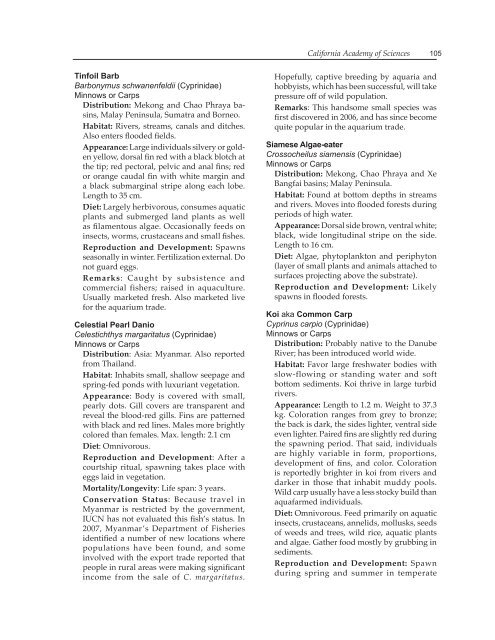THE STEINHART AQUARIUM - Gulf of Guinea Science ...
THE STEINHART AQUARIUM - Gulf of Guinea Science ...
THE STEINHART AQUARIUM - Gulf of Guinea Science ...
You also want an ePaper? Increase the reach of your titles
YUMPU automatically turns print PDFs into web optimized ePapers that Google loves.
Tinfoil Barb<br />
Barbonymus schwanenfeldii (Cyprinidae)<br />
Minnows or Carps<br />
Distribution: Mekong and Chao Phraya basins,<br />
Malay Peninsula, Sumatra and Borneo.<br />
Habitat: Rivers, streams, canals and ditches.<br />
Also enters flooded fields.<br />
Appearance: Large individuals silvery or golden<br />
yellow, dorsal fin red with a black blotch at<br />
the tip; red pectoral, pelvic and anal fins; red<br />
or orange caudal fin with white margin and<br />
a black submarginal stripe along each lobe.<br />
Length to 35 cm.<br />
Diet: Largely herbivorous, consumes aquatic<br />
plants and submerged land plants as well<br />
as filamentous algae. Occasionally feeds on<br />
insects, worms, crustaceans and small fishes.<br />
Reproduction and Development: Spawns<br />
seasonally in winter. Fertilization external. Do<br />
not guard eggs.<br />
Remarks: Caught by subsistence and<br />
commercial fishers; raised in aquaculture.<br />
Usually marketed fresh. Also marketed live<br />
for the aquarium trade.<br />
Celestial Pearl Danio<br />
Celestichthys margaritatus (Cyprinidae)<br />
Minnows or Carps<br />
Distribution: Asia: Myanmar. Also reported<br />
from Thailand.<br />
Habitat: Inhabits small, shallow seepage and<br />
spring-fed ponds with luxuriant vegetation.<br />
Appearance: Body is covered with small,<br />
pearly dots. Gill covers are transparent and<br />
reveal the blood-red gills. Fins are patterned<br />
with black and red lines. Males more brightly<br />
colored than females. Max. length: 2.1 cm<br />
Diet: Omnivorous.<br />
Reproduction and Development: After a<br />
courtship ritual, spawning takes place with<br />
eggs laid in vegetation.<br />
Mortality/Longevity: Life span: 3 years.<br />
Conservation Status: Because travel in<br />
Myanmar is restricted by the government,<br />
IUCN has not evaluated this fish’s status. In<br />
2007, Myanmar’s Department <strong>of</strong> Fisheries<br />
identified a number <strong>of</strong> new locations where<br />
populations have been found, and some<br />
involved with the export trade reported that<br />
people in rural areas were making significant<br />
income from the sale <strong>of</strong> C. margaritatus.<br />
California Academy <strong>of</strong> <strong>Science</strong>s<br />
105<br />
Hopefully, captive breeding by aquaria and<br />
hobbyists, which has been successful, will take<br />
pressure <strong>of</strong>f <strong>of</strong> wild population.<br />
Remarks: This handsome small species was<br />
first discovered in 2006, and has since become<br />
quite popular in the aquarium trade.<br />
Siamese Algae-eater<br />
Crossocheilus siamensis (Cyprinidae)<br />
Minnows or Carps<br />
Distribution: Mekong, Chao Phraya and Xe<br />
Bangfai basins; Malay Peninsula.<br />
Habitat: Found at bottom depths in streams<br />
and rivers. Moves into flooded forests during<br />
periods <strong>of</strong> high water.<br />
Appearance: Dorsal side brown, ventral white;<br />
black, wide longitudinal stripe on the side.<br />
Length to 16 cm.<br />
Diet: Algae, phytoplankton and periphyton<br />
(layer <strong>of</strong> small plants and animals attached to<br />
surfaces projecting above the substrate).<br />
Reproduction and Development: Likely<br />
spawns in flooded forests.<br />
Koi aka Common Carp<br />
Cyprinus carpio (Cyprinidae)<br />
Minnows or Carps<br />
Distribution: Probably native to the Danube<br />
River; has been introduced world wide.<br />
Habitat: Favor large freshwater bodies with<br />
slow-flowing or standing water and s<strong>of</strong>t<br />
bottom sediments. Koi thrive in large turbid<br />
rivers.<br />
Appearance: Length to 1.2 m. Weight to 37.3<br />
kg. Coloration ranges from grey to bronze;<br />
the back is dark, the sides lighter, ventral side<br />
even lighter. Paired fins are slightly red during<br />
the spawning period. That said, individuals<br />
are highly variable in form, proportions,<br />
development <strong>of</strong> fins, and color. Coloration<br />
is reportedly brighter in koi from rivers and<br />
darker in those that inhabit muddy pools.<br />
Wild carp usually have a less stocky build than<br />
aquafarmed individuals.<br />
Diet: Omnivorous. Feed primarily on aquatic<br />
insects, crustaceans, annelids, mollusks, seeds<br />
<strong>of</strong> weeds and trees, wild rice, aquatic plants<br />
and algae. Gather food mostly by grubbing in<br />
sediments.<br />
Reproduction and Development: Spawn<br />
during spring and summer in temperate


